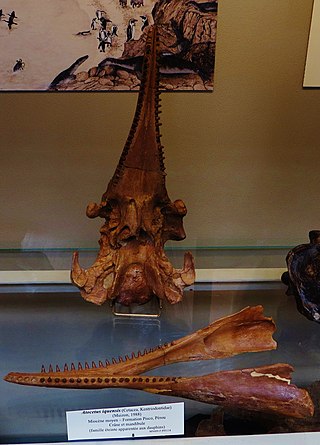
Squalodon is an extinct genus of whales of the Oligocene and Miocene epochs, belonging to the family Squalodontidae. Named by Jean-Pierre Sylvestre de Grateloup in 1840, it was originally believed to be an iguanodontid dinosaur but has since been reclassified. The name Squalodon comes from Squalus, a genus of shark. As a result, its name means "shark tooth". Its closest modern relative is the South Asian river dolphin.

Macrodelphinus is an extinct genus of primitive odontocete known from Early Miocene marine deposits in California.

Zygophyseter varolai is an extinct sperm whale that lived during the Tortonian age of the Late Miocene 11.2 to 7.6 million years ago. It is known from a single specimen from the Pietra Leccese Formation in Italy. It was a member of a stem group of fossil macroraptorial sperm whales also including Brygmophyseter, Acrophyseter, and Livyatan. It probably grew to be around 6.5 to 7 meters in length and shared some characteristics with other raptorials, such as large teeth with tooth enamel that were functional in both the upper and lower jaws which the modern sperm whale lacks. It also had a beak, the ability to echolocate prey, and could have probably swum faster than the modern-day sperm whale which can reach 4 kilometers per hour (2.5 mph). These were probably used in the capture of large prey, such as large fish, seals, and whales. In fact, its common name, the killer sperm whale, refers to its feeding habits that would have had a resemblance to the modern-day killer whale.

Brygmophyseter, known as the biting sperm whale, is an extinct genus of toothed whale in the sperm whale family with one species, B. shigensis. When it was first described in 1994, the species was placed in the genus Scaldicetus based on tooth morphology, but this was later revised in 1995. In 2006, it was classified into the genus Naganocetus, which is considered to be a junior synonym. The only known specimen, a nearly complete skeleton, was dated to be around 16–15 million years old. Brygmophyseter is thought to have been 6.5–7 meters (21–23 ft) long, and it probably had 11 or 12 teeth in the upper and lower jaws. Brygmophyseter is part of a group of macroraptorial sperm whales which tended to be apex predators using their large teeth to catch struggling prey such as whales. It had a spermaceti organ which was probably used for biosonar like in the modern sperm whale. The whale has made an appearance on The History Channel's TV series Jurassic Fight Club.

Kentriodontidae is an extinct family of odontocete whales related to modern dolphins. The Kentriodontidae lived from the Oligocene to the Pliocene before going extinct.

Acrophyseter is a genus of extinct sperm whale that lived in the Late Miocene off the coast of what is now Peru. The genus comprises two species: A. deinodon and A. robustus. It is part of a group of macroraptorial sperm whales that all share several features for hunting large prey, such as deeply rooted and thick teeth. Acrophyseter measured 4–4.5 metres (13–15 ft) in length, making it the smallest macroraptorial sperm whale currently known. Because of its short pointed snout and strongly curved front teeth, it probably fed on the large marine vertebrates of its time, such as seals and other whales.

Scaldicetus is an extinct genus of highly predatory macroraptorial sperm whale. Although widely used for a number of extinct physeterids with primitive dental morphology consisting of enameled teeth, Scaldicetus as generally recognized appears to be a wastebasket taxon filled with more-or-less unrelated primitive sperm whales.
Huaridelphis is an extinct genus of river dolphins from the Early Miocene. The type species is H. raimondii, found in the Chilcatay Formation of the Pisco Basin.

Otekaikea is an extinct genus of toothed whale closely related to Waipatia. It is known from the late Oligocene (Chattian) of New Zealand.

Atocetus is an extinct genus of pontoporiid dolphin found in Miocene-age marine deposits in Peru and California.
Zarhinocetus is an extinct genus of whale from the Early to Middle Miocene of the eastern North Pacific.
Notocetus is an extinct genus of river dolphin belonging to Squalodelphinidae. Known specimens have been found in Early Miocene marine deposits from Argentina, Italy and Peru.
Squaloziphius is an extinct genus of odontocete cetacean from the Early Miocene (Aquitanian) aged marine deposits in Washington state.

Agorophius is an extinct genus of toothed whale that lived during the Oligocene period, approximately 32 million years ago, in the waters off what is now South Carolina.

Albertocetus is an extinct genus of primitive odontocete cetacean from early Oligocene (Rupelian) marine deposits in North Carolina, and belonging to the family Xenorophidae.
Chilcacetus is an extinct genus of primitive odontocete known from Early Miocene (Aquitanian) of Peru. Fossils were found in and named after the Chilcatay Formation of the Pisco Basin.
Macrosqualodelphis is an extinct genus of river dolphins from the Early Miocene (Burdigalian) Chilcatay Formation of the Pisco Basin, Peru. The type species is M. ukupachai.
Hoplocetus is an extinct genus of raptorial cetacean of the sperm whale superfamily, Physeteroidea. Its remains have been found in the Miocene of Belgium, France, Germany and Malta, the Pliocene of Belgium and France, and the Pleistocene of the United Kingdom and South Carolina.
Pisco Basin is a sedimentary basin extending over 300 kilometres (190 mi) in southwestern Peru. The basin has a 2 kilometres (6,600 ft) thick sedimentary fill, which is about half the thickness of more northern foreland basins in Peru.










